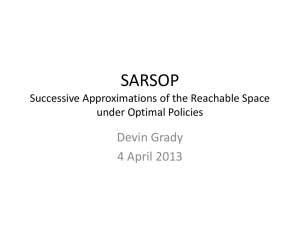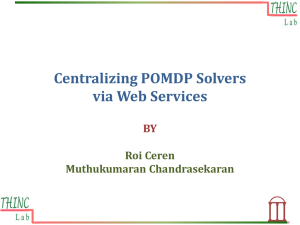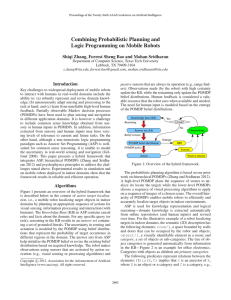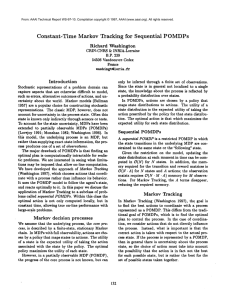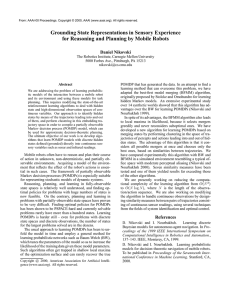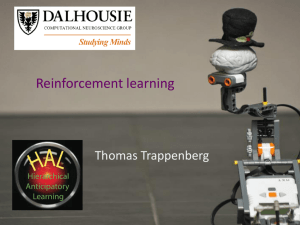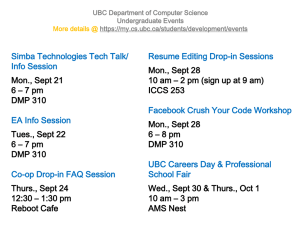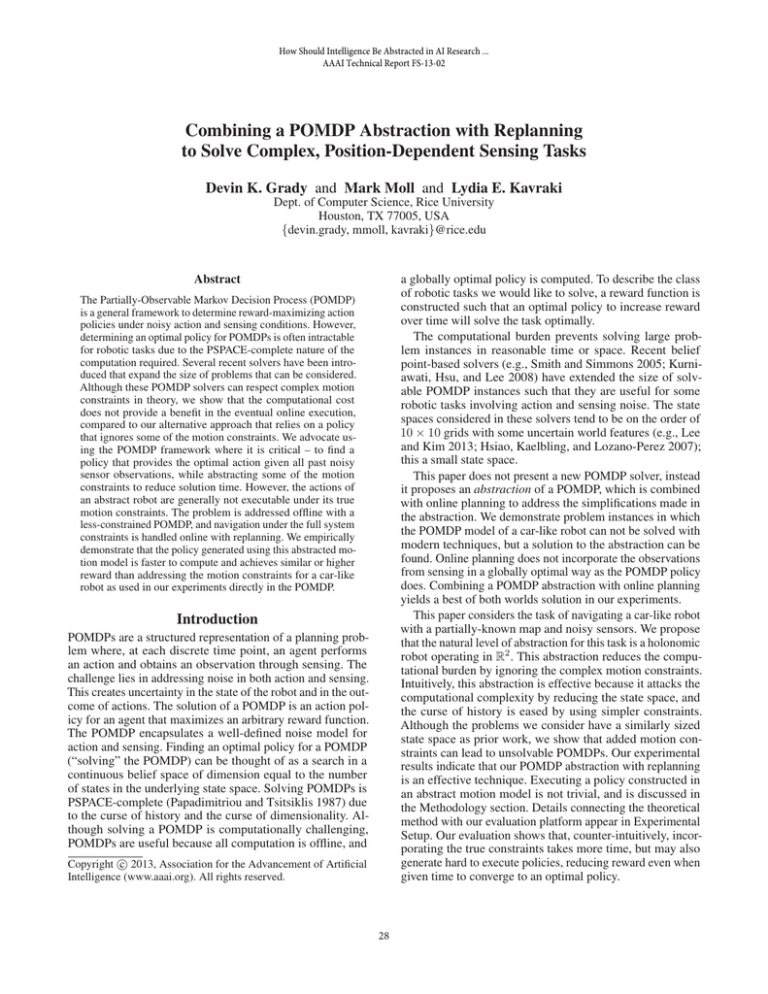
How Should Intelligence Be Abstracted in AI Research ...
AAAI Technical Report FS-13-02
Combining a POMDP Abstraction with Replanning
to Solve Complex, Position-Dependent Sensing Tasks
Devin K. Grady and Mark Moll and Lydia E. Kavraki
Dept. of Computer Science, Rice University
Houston, TX 77005, USA
{devin.grady, mmoll, kavraki}@rice.edu
Abstract
a globally optimal policy is computed. To describe the class
of robotic tasks we would like to solve, a reward function is
constructed such that an optimal policy to increase reward
over time will solve the task optimally.
The computational burden prevents solving large problem instances in reasonable time or space. Recent belief
point-based solvers (e.g., Smith and Simmons 2005; Kurniawati, Hsu, and Lee 2008) have extended the size of solvable POMDP instances such that they are useful for some
robotic tasks involving action and sensing noise. The state
spaces considered in these solvers tend to be on the order of
10 × 10 grids with some uncertain world features (e.g., Lee
and Kim 2013; Hsiao, Kaelbling, and Lozano-Perez 2007);
this a small state space.
This paper does not present a new POMDP solver, instead
it proposes an abstraction of a POMDP, which is combined
with online planning to address the simplifications made in
the abstraction. We demonstrate problem instances in which
the POMDP model of a car-like robot can not be solved with
modern techniques, but a solution to the abstraction can be
found. Online planning does not incorporate the observations
from sensing in a globally optimal way as the POMDP policy
does. Combining a POMDP abstraction with online planning
yields a best of both worlds solution in our experiments.
This paper considers the task of navigating a car-like robot
with a partially-known map and noisy sensors. We propose
that the natural level of abstraction for this task is a holonomic
robot operating in R2 . This abstraction reduces the computational burden by ignoring the complex motion constraints.
Intuitively, this abstraction is effective because it attacks the
computational complexity by reducing the state space, and
the curse of history is eased by using simpler constraints.
Although the problems we consider have a similarly sized
state space as prior work, we show that added motion constraints can lead to unsolvable POMDPs. Our experimental
results indicate that our POMDP abstraction with replanning
is an effective technique. Executing a policy constructed in
an abstract motion model is not trivial, and is discussed in
the Methodology section. Details connecting the theoretical
method with our evaluation platform appear in Experimental
Setup. Our evaluation shows that, counter-intuitively, incorporating the true constraints takes more time, but may also
generate hard to execute policies, reducing reward even when
given time to converge to an optimal policy.
The Partially-Observable Markov Decision Process (POMDP)
is a general framework to determine reward-maximizing action
policies under noisy action and sensing conditions. However,
determining an optimal policy for POMDPs is often intractable
for robotic tasks due to the PSPACE-complete nature of the
computation required. Several recent solvers have been introduced that expand the size of problems that can be considered.
Although these POMDP solvers can respect complex motion
constraints in theory, we show that the computational cost
does not provide a benefit in the eventual online execution,
compared to our alternative approach that relies on a policy
that ignores some of the motion constraints. We advocate using the POMDP framework where it is critical – to find a
policy that provides the optimal action given all past noisy
sensor observations, while abstracting some of the motion
constraints to reduce solution time. However, the actions of
an abstract robot are generally not executable under its true
motion constraints. The problem is addressed offline with a
less-constrained POMDP, and navigation under the full system
constraints is handled online with replanning. We empirically
demonstrate that the policy generated using this abstracted motion model is faster to compute and achieves similar or higher
reward than addressing the motion constraints for a car-like
robot as used in our experiments directly in the POMDP.
Introduction
POMDPs are a structured representation of a planning problem where, at each discrete time point, an agent performs
an action and obtains an observation through sensing. The
challenge lies in addressing noise in both action and sensing.
This creates uncertainty in the state of the robot and in the outcome of actions. The solution of a POMDP is an action policy for an agent that maximizes an arbitrary reward function.
The POMDP encapsulates a well-defined noise model for
action and sensing. Finding an optimal policy for a POMDP
(“solving” the POMDP) can be thought of as a search in a
continuous belief space of dimension equal to the number
of states in the underlying state space. Solving POMDPs is
PSPACE-complete (Papadimitriou and Tsitsiklis 1987) due
to the curse of history and the curse of dimensionality. Although solving a POMDP is computationally challenging,
POMDPs are useful because all computation is offline, and
c 2013, Association for the Advancement of Artificial
Copyright Intelligence (www.aaai.org). All rights reserved.
28
Problem Definition
To represent a car-like model, the state space S is the
continuous space of rigid body poses in the plane, denoted
as SE(2). Action space A will be discretized for computational efficiency into 5 actions as shown in Figure 2. Sensor
observations consist of (x, y, range) tuples, discretized to
integral values. T will be a Gaussian distribution centered
around the expected outcome from the motion model. Ω will
implement a similar Gaussian noise model for sensing. The
current orientation, θ, is noise-free. We will define the reward
function R to be independent of A and only depend on S.
The discount factor, γ, encourages short policies as in all
known prior finite-time horizon POMDP planning.
As we will show, computing even an approximate policy for P is intractable, despite the discretization of sensing and action. Therefore, this paper proposes an abstracted
POMDP model, P 0 = hS 0 , A0 , O, T 0 , Ω, R, γi. Although
the motion model has changed (S 0 , A0 , T 0 ), the components
of the task description that will not be addressed with replanning are unchanged (O, Ω, R, γ). In P 0 , S 0 = R2 ,
A0 = {North, South, East, West, Stop}, and T 0 is the same
Gaussian, but centered on the state returned by this simpler
motion model.
For comparison purposes, we solve both P and P 0 using
the powerful solver MCVI, and the policies generated will
be used in online execution. The task is complete, either
in success or failure, when the policy update of the online
execution indicates that the robot has entered a terminal state.
The task we set out to solve is an escape problem, where a
robotic agent must avoid detection. This robot has a radio
signal strength sensor that estimates the distance to a radio
source emanating from an adversarial detection outpost. The
problem is to determine a sensor-based policy that a car-like
robot can follow without detection to a goal region. There
are some existing, known obstacles in the workspace, as well
as one possible unknown obstacle. The range to the unknown
obstacle can be sensed, however the sensor is noisy and
noise increases with range. Additionally, only noisy position
sensing is available, preventing the agent from ever fully
localizing.
Our problem is similar in construction to RockSample,
introduced on 7 × 7 grids (Smith and Simmons 2004), since
expanded and modified (Zhang and Chen 2010; Bai et al.
2010). Similar to RockSample, the environment is defined as
a grid, and there exists an exit region that is rewarding and
terminal. Unlike RockSample, costly and terminal obstacles
exist. RockSample, unlike our problem, has perfect localization. In addition, our variables for sensing the environment
are not boolean values of rocks with known positions but,
instead, are range measurements to a terminal obstacle with
unknown position. Overall, these modifications make this
new problem much more difficult.
The POMDP representing this task is defined as P0 =
hS, A0 , O0 , T0 , Ω0 , R, γi, and is the input to our algorithm.
S = Continuous State Space
A0 = Continuous Action Space
O0 = Continuous Observation Space
T0 = Transition Probabilities (S × A0 × S) ⇒ R
Ω0 = Observation Probabilities (S × A0 × O0 ) ⇒ R
R = Reward Function(S × A) ⇒ R
γ = Discount Factor (0.95)
Related Work
The two-phase method we propose may appear similar to
hierarchical POMDP methods (Foka and Trahanias 2007;
Pineau, Roy, and Thrun 2001; Pineau et al. 2003). However,
these methods generate POMDP policies “all the way down”
to the full system detail through decomposition of the state,
action, and sensor spaces. Our proposal instead uses an abstracted POMDP, and then applies replanning to incorporate
the constraints.
Point-Based Policy Transformation (PBPT) (Kurniawati
and Patrikalakis 2012) and online POMDP methods (Wang
and Dearden 2012; Ross et al. 2008) propose a similar idea to
this paper, by limiting offline computation and then fixing the
policy when necessary to decrease the required offline computation time. However, we are breaking out of the POMDP
framework entirely and not changing the input policy. In our
work, the input POMDP policy is for an abstracted model,
therefore replanning is necessary to execute the policy. PBPT
uses a bijection S ⇔ S 0 and A ⇔ A0 . We will be operating
in state spaces that differ in dimensionality, and our action
spaces have very different constraints, precluding the applicability of PBPT. These changes in state and action spaces
are precisely what drives the computational benefits of our
proposed framework.
There has been significant interest recently in problems
where a belief can be approximated by a Gaussian distribution
(Bai, Hsu, and Lee 2013; Van den Berg, Patil, and Alterovitz
2012). Although we use Gaussian distributions in our sensor
model, the belief state of the world cannot effectively be
collapsed into a unimodal distribution due to the uncertainty
The output is a sequence of states (execution trace) that
follow the propagation of a simulated car-like robot. An
execution trace has a reward calculated using R and γ from
above. We define success as when a trace ends in a terminal
exit region, and failure is all other traces.
Overall Approach
P0 is useful to describe the underlying continuous problem,
however, continuous action spaces have only recently been
addressed using techniques from sampling-based planning to
find useful action samples (Kurniawati, Bandyopadhyay, and
Patrikalakis 2012). We directly define a solvable POMDP
abstraction as P = hS, A, O, T, Ω, R, γi where A and O are
discretized approximations of A0 and O0 . T and Ω are then
functions over these discretized spaces. Modern solvers, such
as Monte-Carlo Value Iteration (MCVI) (Lim, Hsu, and Lee
2011), can solve a POMDP in this form.
The stealth escape problem will be solved in two stages:
1. Offline POMDP policy generation, and
2. Online replanning agent policy execution.
29
of the location of obstacles. Therefore, these extremely fast
and effective techniques are not applicable to our problem.
In (Candido and Hutchinson 2011), a method similar to
MCVI is proposed for an explicit belief variance minimization and navigation task. Local policies are explicitly userdesigned and given as input. These local policies are designed
to decrease uncertainty in the current belief and drive the system to a goal state. This will allow the use of high-level
abstract actions similar to our method, however, our technique builds per-action policies online instead of using user
defined policies, and we use MCVI, which converges to optimal policies.
Recent efforts to improve POMDP solution times by decreasing the number of states (Agha-mohammadi, Chakravorty, and Amato 2011; Kurniawati, Bandyopadhyay, and
Patrikalakis 2012; Kaplow, Atrash, and Pineau 2010) and actions (Grady, Moll, and Kavraki 2013) are also relevant to our
goal of decreased computation time without sacrificing reward. In general, these methods will produce abstractions of
navigation and/or carve out “interesting” areas of the spaces
to focus on. Unlike in this paper, the discretizations are altered while the underlying motion constraints and state spaces
are unchanged.
POMDP+Online is a high-level view, and wraps up a several important details in the functions called Solve(), Plan(),
and SampleObs(). Many of these implementation details will
be covered in the Methodology and Experimental Setup sections. Critical to our combination of an offline policy and
online replanning is having the correct goal state for Plan(),
and we will expand that function here.
Algorithm 2 Plan() from line 7 of POMDP+Online
Require: start is a valid continuous state for planner
Require: policyNode is a node in policy
Require: P is a POMDP model
1: maxReward ← P .minReward()
2: bestFuture ← NULL
3: for i = 1 . . . N do
4:
future, reward ← Simulate(policyNode, P )
5:
if reward ≥ maxReward then
6:
bestFuture ← future
7:
maxReward ← reward
8:
end if
9: end for
10: goal ← GoalSelect(bestFuture)
11: path ← planner.plan(start, goal)
12: return path
Methodology
The proposed algorithm, Algorithm 1: POMDP+Online, operates in two phases. Line 1 is the entire offline solution phase,
taking the input POMDP model and getting an optimal policy.
Lines 2–4 set up the initial state of the replanning system.
Line 5 initializes the output of the execution trace. Lines
6–12 perform the replanning loop until a terminal observation is sensed, appending to the execution trace after each
action. Finally, on line 13, the execution trace is returned as
output.. The policy is represented as a deterministic policy
graph, where each node is the optimal action and edges are
taken dependent on observations. The policy node update
on line 11 thus depends on the observation (from line 10)
This observation may be critical to the overall reward, as
noisy sensing plays a pivotal role in the task. Therefore, the
execution of each action is planned independently (line 7).
This ensures that policy node updates are done correctly and
the agent follows the reward-maximizing policy from line 1.
A brief walkthrough of Plan() starts at the initialization
on lines 1–2. The loop on lines 3–9 finds the best possible
future trajectory over N simulations. At the end of this loop,
bestFuture is the set of states along this best possible future
trajectory. This is used on line 10 to access bestFuture[1], the
next state from the best future. Line 10 selects a goal – when
P and planner have different state spaces this is non-trivial
and will be discussed later. Finally, on line 11 the planner is
actually called to solve the motion planning problem, and the
path found is returned on line 12.
The call to planner.plan on line 10 of Algorithm 2 must
generate collision-free trajectories that respect the system
constraints. The online system is also computationally constrained for each cycle. During online execution, the same
noise model is applied as in the offline stage. Due to the
computation budget and noise, even simple problems and environments fail occasionally. This occurs when Plan() returns
an empty path because the planner could not connect the start
and goal states given the constraints of the system.
Algorithm 1 POMDP+Online
Require: P is a POMDP model
1: policy ← Solve(P )
. Offline Planning
2: state ← SampleInitState(P )
. Initialization
3: policyNode ← policy.root(P )
4: obs ← SampleObs(state, policyNode, P )
5: trace ← {state}
6: repeat
. Online replanning loop
7:
path ← Plan(obs.state(), policy, policyNode, P )
8:
state ← state.IntegrateAlong(path)
9:
trace.append(state)
10:
obs ← SampleObs(state, policyNode, P )
11:
policyNode ← policyNode.child(obs)
12: until TerminalObservation(obs)
13: return trace
Experimental Setup
In this section, we will first give the details of the offline
models, P and P 0 . We will proceed to provide the details of
our implementation of online replanning. These details will
give the algorithms presented earlier some concrete structure.
Both P and P 0 share a common noise model for sensing,
shown in Figure 1. Position sensing noise is applied by drawing a Gaussian sample around the true state, with σ = 0.2,
and then only the integer part is returned. The range sensor
observations follow the same general noise model, except
that σ is multiplied by the current true range. Therefore, the
range sensor samples from a discretized Gaussian centered
around the true range to the unknown obstacle. Because our
30
Figure 1: Position (left) and range (right) sensing noise models are Gaussian distributions truncated to integral values.
Figure 2: The action model of P .
sensing model does not depend on orientation, P 0 still captures the essential characteristics of our task, but under fewer
motion constraints.
For offline planning, MCVI is used. MCVI is a limited time
horizon offline planner. We set the horizon to 100 actions.
For our problems, the policies produced by MCVI always
terminated significantly before this cutoff.
The action space A is shown in Figure 2. A is a discretizedaction first-order robot with bounded curvature. This robot
model is a discretized version of the online system that will be
discussed later in this section. A does not allow the system to
back up since, in the task we are solving, reverse movement is
of little use at the POMDP level. A0 consists of the 4 cardinal
directions with unit length, plus staying still.
The reward function R is assumed constant over unit
squares of R2 , and R is exactly the definition of the environment. Obstacles and exit regions are sets of terminal
states. P or P 0 is solved with MCVI, and a policy mapping
observations to actions is returned. This reward-maximizing
policy will be followed one action at a time with an online
system that does respect all the constraints of the system.
The online planner uses locally-optimal Dubins (Dubins
1957) and Reeds-Shepp (Reeds and Shepp 1990) paths. These
first-order, bounded-curvature paths are time-independent,
kinematically valid paths for many car and UAV models.
Controllers can easily track these paths under the full system
dynamics. The Reeds-Shepp model is almost identical to the
Dubins model with the additional ability to go backward.
Reeds-Shepp paths clearly are not valid for fixed-wing UAVs,
but are more applicable to car-like UGVs. The difficulty of
online planning is in satisfying the motion constraints while
executing the input policy. Being able to reverse allows the
Reeds-Shepp car to easily approach a target orientation and
correct for position noise. The effect of this will be seen in
the solution percentages.
Transition-based RRT (Jaillet, Cortes, and Siméon 2008)
was chosen for online replanning because it plans in a space
with an arbitrary reward function to produce low-cost paths.
TRRT reward is based on the executions of the policy and
the POMDP reward function R. This directly couples the
online replanning with the offline policy at a low level. Online
replanning is implemented using the open-source OMPL
package (Şucan, Moll, and Kavraki 2012). Dubins and ReedsShepp models with a minimum turning radius of 0.5 are
Figure 3: Environments used in trials. They are: (a) empty,
(b) single stealth, (c) double stealth, and (d) slalom.
instantiated. N = 1000 runs of the policy are executed from
the current state, given all previous sensor measurements.
A benefit of our technique is that the same offline policy
can be utilized for multiple online systems. In this paper,
we will take advantage of this abstraction and compute one
policy offline, and then execute it under two different vehicle
models, each with its own set of constraints. This represents
the potential for massive computational savings, as it indicates that a policy does not need to be re-calculated for small
differences in system constraints.
The noise model in the online stage is the same as in P
and P 0 . As we are not testing the effectiveness of online
localization algorithms, we have omitted implementing such
algorithms. Omitting localization at the online stage is not a
limitation of the method, but will negatively affect success
rates. Because it affects all experimental conditions equally, it
changes the overall results by a uniform reduction in reward
and success rates.
As discussed earlier, execution of the policy is done one
POMDP action at a time, by computing an intermediate goal
that accomplishes each action (Algorithm 2, line 10). Each
intermediate goal is a state (x, y, θ), where θ is taken directly
from the P policy, and is predicted with a 2-action lookahead
when using the P 0 policy. This prediction considers the direction of the action that joins the next and the next-next state,
and then assigns that direction as the goal orientation. If there
is only 1 state in the future of either the P or P 0 policy, then
it is assumed to be a final state and an escape goal is used
that does not constrain orientation or position within the exit
region.
Experimental Evaluation
The environments used are depicted in Figure 3. Most of the
space has reward of −1 (gray), terminal escape regions have
reward +900 (white), and the terminal obstacle regions have
a reward of −1000 (black). The large grey circles are the pos-
31
Figure 4: Experimental results are presented in this summary figure. Striped bars used P , solid bars used P 0 .
sible locations of the unknown obstacle. There are also large
grey circles and small green circles. The small green circle
is an initial belief 95% confidence circle. No green circle
appears in the slalom environment because this environment
was run without position noise. Possible obstacle positions
are placed so that, without sensing the unknown obstacle’s
location, reaching a state with positive reward is unlikely.
Metrics tested are total solution time, policy execution
reward, and task success rate. Each metric is computed across
500 trials in each environment and the mean value is shown
with a 95% confidence interval in Figure 4. Although solution
time is inclusive of both the offline POMDP solution and
online replanning, the online time is negligible in all but the
simplest tests. To compare between the policies generated
from P and P 0 , reward is considered at the online level.
This is the reward the robot is actually getting under the true
constraints. Each set of bars shows a comparison of the policy
generated by solving P and the policy from solving P 0 , when
each are executed on the Dubins and Reeds-Shepp models.
The first test, Figure 3(a), was an empty environment, only
limited by the bounds and kinematics of the system. In this
test, we see that the total computation time for P is more
than an order of magnitude greater than for P 0 (note the log
scale). The success rate and reward shows that the policies
for P and P 0 were equally optimal.
In the stealth single passage problem in Figure 3(b), neither
policy is optimal within time limits, however, the policy for
the simpler POMDP abstraction P 0 achieves significantly
higher reward for both robot models. This test shows that the
policy for the more complex POMDP was not just somewhat
worse, but performed no better than chance. We conclude
that all of the time was spent in determining a policy for only
the navigational aspects of the problem, without being able to
build a large enough policy to localize the unknown obstacle.
For the stealth double passage in Figure 3(c), making the
wrong navigation decision based on the noisy sensing is
catastrophic. This makes the problem harder than the single
passage problem. If P 0 is used to generate a policy, the Dubins model gets negative reward. The same policy executed
under the Reeds-Shepp car model achieves a very high success rate and a positive reward. From this we can conclude
that the policy was good, but actually following it was difficult for the Dubins model. When simulations were visualized,
it was apparent that turning corners was often problematic for
the Dubins model, as it would often compute paths that were
believed to be barely collision free, and, due to the position
sensing noise, were actually in collision.
In the slalom environment in Figure 3(d), the noise model
was too challenging for either P or P 0 to produce a policy
that had a non-zero success rate. We expect this is due to the
large number of turns that are made, a difficulty discussed
above. Results from this environment were therefore obtained
without position noise. In this case, MCVI can find an optimal
policy for both P and P 0 . Note the system does not reduce
to an MDP because the unknown obstacle is only partially
observable. Due to the increased clutter, the difficulty of
achieving specific orientations is highlighted by the reward
and success degradation when using the policy from P .
When MCVI converges for both models, P converges
significantly faster and the reward of both policies are approximately equal. When MCVI times out, it is clear that the
policy from P 0 is closer to optimal and yields significantly
higher reward. The generality of online replanning is hinted
at by using a single offline policy for two online models.
Discussion
To address sensing-based robotic tasks with a complex reward structure, we propose that the correct level of abstrac-
32
tion is to remove complex motion constraints from a POMDP.
Removed constraints can be incorporated online with replanning. Our results show that, for the problem instances we
have considered, our proposed algorithm is superior.
It is clear from our results that complex constraints may
cause an explosion in the computation time such that the
policy returned may have extremely poor success rates – 0%
in some cases. Delaying the consideration of these constraints
is shown to be an effective strategy to generate better policies
and improve success rates.
For the future, it is clear that a localization algorithm will
be required. Implementing this addition may make the results
harder to analyze, but will help improve success rates. We
are also interested in investigating more complex search-andrescue tasks where the goal may be unknown.
IEEE/RSJ Intl. Conf. on Intelligent Robots and Systems, 2145–
2150.
Kaplow, R.; Atrash, A.; and Pineau, J. 2010. Variable resolution decomposition for robotic navigation under a POMDP
framework. In IEEE Intl. Conf. on Robotics and Automation,
369–376.
Kurniawati, H., and Patrikalakis, N. M. 2012. PointBased Policy Transformation : Adapting Policy to Changing
POMDP Models. In Workshop on the Algorithmic Foundations of Robotics, 1–16.
Kurniawati, H.; Bandyopadhyay, T.; and Patrikalakis, N. M.
2012. Global motion planning under uncertain motion, sensing, and environment map. Autonomous Robots.
Kurniawati, H.; Hsu, D.; and Lee, W. S. 2008. SARSOP:
Efficient point-based POMDP planning by approximating
optimally reachable belief spaces. In Robotics: Science and
Systems.
Lee, T., and Kim, Y. J. 2013. GPU-based Motion Planning
under Uncertainties using POMDP. In IEEE Intl. Conf. on
Robotics and Automation.
Lim, Z.; Hsu, D.; and Lee, W. S. 2011. Monte Carlo Value
Iteration with Macro-Actions. In Advances in Neural Information Processing Systems.
Papadimitriou, C., and Tsitsiklis, J. 1987. The complexity
of Markov decision processes. Mathematics of operations
research 12(3):441–450.
Pineau, J.; Montemerlo, M.; Pollack, M.; Roy, N.; and Thrun,
S. 2003. Towards robotic assistants in nursing homes: Challenges and results. Robotics and Autonomous Systems 42(34):271–281.
Pineau, J.; Roy, N.; and Thrun, S. 2001. A hierarchical
approach to POMDP planning and execution. In Workshop
on Hierarchy and Memory in Reinforcement Learning.
Reeds, J. A., and Shepp, L. A. 1990. Optimal paths for a car
that goes both forwards and backwards. Pacific Journal of
Mathematics 145(2):367–393.
Ross, S.; Pineau, J.; Paquet, S.; and Chaib-Draa, B. 2008. Online Planning Algorithms for POMDPs. Journal of Artificial
Intelligence Research 32(2):663–704.
Smith, T., and Simmons, R. 2004. Heuristic search value
iteration for POMDPs. In Conf. on Uncertainty in Artificial
intelligence, 520—-527.
Smith, T., and Simmons, R. 2005. Point-based POMDP
algorithms: Improved analysis and implementation. In Uncertainty in Artificial Intelligence.
Şucan, I. A.; Moll, M.; and Kavraki, L. E. 2012. The Open
Motion Planning Library. IEEE Robotics & Automation
Magazine 19(4):72—-82.
Wang, M., and Dearden, R. 2012. Improving Point-Based
POMDP Policies at Run-Time. In Workshop of the UK Planning And Scheduling SIG.
Zhang, Z., and Chen, X. 2010. Accelerating Point-Based
POMDP Algorithms via Greedy Strategies. Simulation, Modeling, and Programming for Autonomous Robots 6472:545–
556.
Acknowledgements This work was partially supported by NSF
1139011, NSF DUE 0920721, CCF 1018798 and the U. S. Army
Research Laboratory and the U. S. Army Research Office under
grant number W911NF-09-1-0383. Equipment funded in part by the
Data Analysis and Visualization Cyberinfrastructure funded by NSF
under grant OCI-0959097. D. Grady was additionally supported by
an NSF Graduate Research Fellowship.
References
Agha-mohammadi, A.-a.; Chakravorty, S.; and Amato, N. M.
2011. FIRM: Feedback controller-based information-state
roadmap - A framework for motion planning under uncertainty. In IEEE/RSJ Intl. Conf. on Intelligent Robots and
Systems, volume 1, 4284–4291.
Bai, H.; Hsu, D.; Lee, W. S.; and Ngo, V. 2010. Monte Carlo
value iteration for continuous-state POMDPs. In Workshop
on the Algorithmic Foundations of Robotics, 175–191.
Bai, H.; Hsu, D.; and Lee, W. S. 2013. Planning How to
Learn. In IEEE Intl. Conf. on Robotics and Automation.
Van den Berg, J.; Patil, S.; and Alterovitz, R. 2012. Efficient approximate value iteration for continuous Gaussian
POMDPs. In AAAI Conf. on Artificial Intelligence, 1832–
1838.
Candido, S., and Hutchinson, S. 2011. Minimum uncertainty
robot navigation using information-guided POMDP planning.
In IEEE Intl. Conf. on Robotics and Automation, 6102–6108.
Dubins, L. E. 1957. On curves of minimal length with a
constraint on average curvature, and with prescribed initial
and terminal positions and tangents. American Journal of
Mathematics 79(3):497–516.
Foka, A., and Trahanias, P. 2007. Real-time hierarchical
POMDPs for autonomous robot navigation. Robotics and
Autonomous Systems 55(7):561–571.
Grady, D.; Moll, M.; and Kavraki, L. E. 2013. Automated
Model Approximation for Robotic Navigation with POMDPs.
In IEEE Intl. Conf. on Robotics and Automation.
Hsiao, K.; Kaelbling, L. P.; and Lozano-Perez, T. 2007.
Grasping POMDPs. In IEEE Intl. Conf. on Robotics and
Automation, 4685–4692.
Jaillet, L.; Cortes, J.; and Siméon, T. 2008. Transitionbased RRT for path planning in continuous cost spaces. In
33


